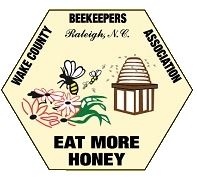 | Wake County Beekeepers Association |
 Help I've got Bees!
Help I've got Bees!
The WCBA is here to serve the community when a swarm of honeybees shows up. Many of our members are willing and able to remove swarms for free.
Below are some guidelines for folks when encountering honeybee swarms and who to call for assistance.
WCBA Members Only – Swarm list guidelines
What to do
-
CALL RIGHT AWAY, DON'T SPRAY! Honeybee swarms are calm. They will leave you alone if you leave them alone. They are just stopping on their way to finding a new permanent home.
-
Determine whether they are honeybees. WCBA members will only remove honeybee swarms or hives. Honeybees are hairy, while hornets and wasps are hairless and shiny. If you send us a picture, we can check whether you have honey bees, or something else. Sadly, we cannot not assist with wasps, hornets or other insects.
-
Is it a swarm? Some bees may be flying around but that does not mean there is a swarm. A swarm is a clump or cluster of bees, usually between the size of a soft ball or beach ball. (see the picture below). Often, they can be found hanging on a branch or against a structure. Swarms appear most often from early March through July.
-
Call as soon as you notice the swarm! When bees swarm, time is of the essence. Swarms are relatively easy to catch, but will only stay in the open for a few hours before finding a refuge. Once they find a defensible nesting site – inside a tree, wall or attic – capture is much more difficult.
When you call, be ready to share…
-
WHO: Please provide your name, address and telephone number.
-
WHAT: Are you sure it’s honeybees? Take a photo of the swarm and text it to the swarm captain for your area. (See the map below.)
-
WHEN: When did you first see the bees, and how long have they been there?
-
WHERE: What is the address where they are located? Who is the property owner? If not, who is the owner? The more detail about the location, the easier it will be for the volunteer to collect the swarm.
-
HOW MANY: What size is the swarm ball – like a softball? basketball? beach ball?
-
HOW HIGH: How high off the ground are they? Are they in a tree or bush? Can the tree or shrub limb be cut if necessary? Will a ladder be needed?
Who to Call
Volunteers are divided by 5 geographic locations, or zones, covering all of Wake County. Please contact the swarm captain for the location of the swarm (see the list below).

| If you do not receive an answer when calling the zone captain, please leave a message and wait 5 minutes for a return call before calling other captains. |
